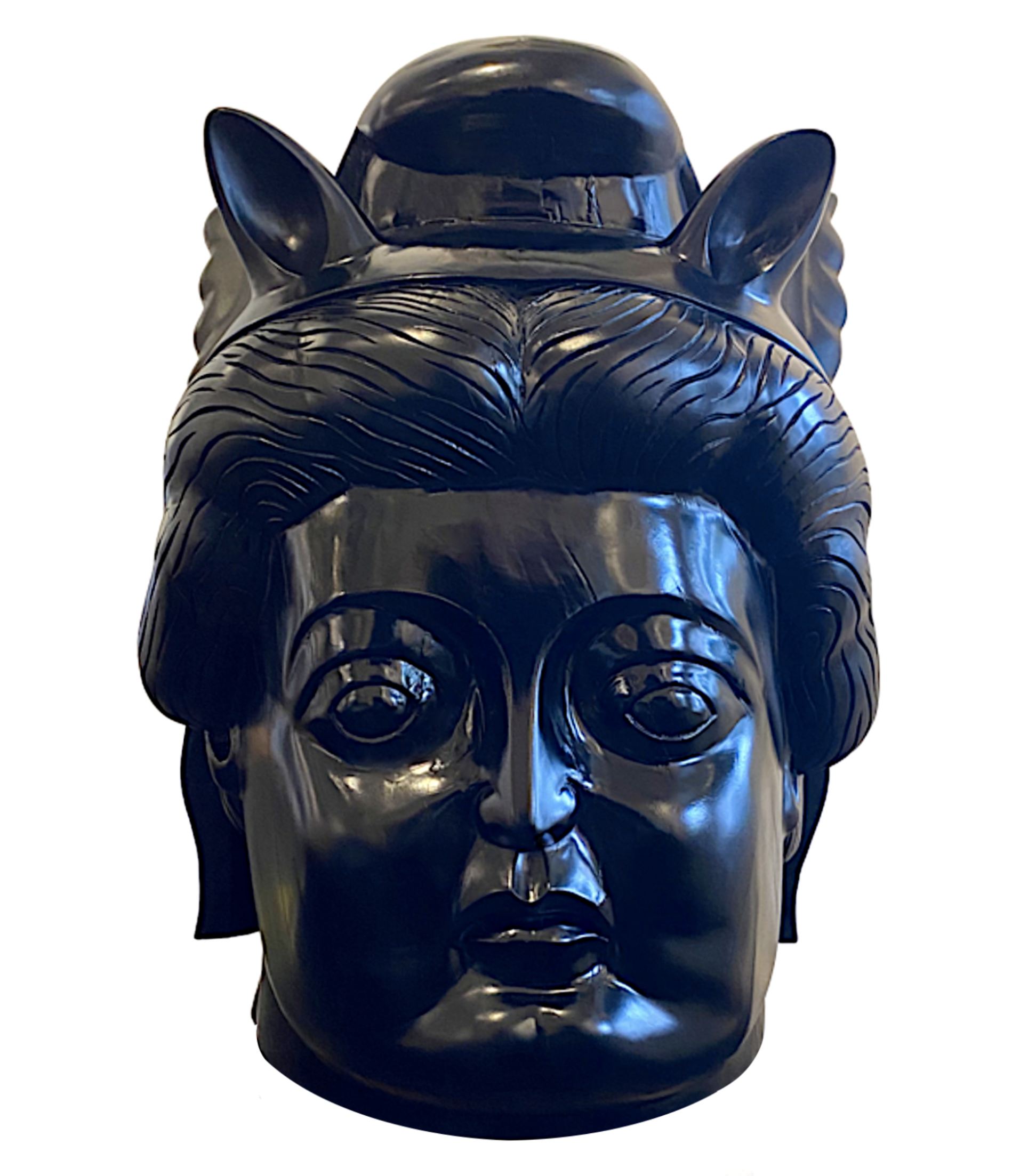

Title: Contemporary Wooden mythical Head Sculpture in the style of Botero
Shipping: $29.00
Artist: N/A
Period: Contemporary
History: Art
Origin: North America > United States
Condition: Good
Item Date: N/A
Item ID: 416
This very large, heavy contemporary wooden sculpture—painted black—depicts a stylized carving of a woman’s head. The form recalls Perseus wearing a Phrygian cap with wings, while also resembling the modernized figure of Liberty as seen on the vintage U.S. dime first minted in 1916. The work has been attributed to the celebrated Colombian artist Fernando Botero, although we have not yet been able to authenticate it. Measurements: 25" tall × 17" wide × 16" deep. The sculpture is made of solid wood and weighs approximately 100 pounds. We believe the inspiration for this sculpture draws from both Greek mythology and American numismatic history. The 1916 dime, popularly known as the “Mercury dime,” features a youthful Liberty wearing a winged cap. While often mistaken for the Roman god Mercury, the design actually reflects a Phrygian cap—a traditional symbol of freedom and liberty. In Greek mythology, Perseus was also depicted with a winged cap, while the mythical King Midas of Phrygia was known for hiding his donkey’s ears beneath such headgear. The Phrygian cap, therefore, carried associations of myth, nobility, and symbolic disguise. The goddess Cybele, mother of the gods, was also closely associated with the Phrygian cap. Worshiped as a patron of fertility and protector of wild animals, she was frequently portrayed with lions and other symbols of nature. Greek sculptures often depict figures such as Castor, Pollux, Amazons, and other heroes wearing the cap. In the ancient world, headgear was a powerful identifier—instantly revealing status, occupation, ethnicity, gender, or religious affiliation. Craftsmen, for example, could be recognized by their simple felt hats. Fernando Botero, one of the most successful living artists, has long been fascinated by such ancient symbolism. His monumental sculptures—displayed from Bogotá to Paris, New York to Hong Kong—are celebrated for their voluptuous forms and their ability to integrate timeless themes into the modern urban landscape. Since beginning his sculptural career in the mid-1970s, Botero has consistently drawn inspiration from antiquity, much like the Italian Baroque masters who revered classical forms as foundations of Western visual culture. The Phrygian cap itself has a long and evolving history as a symbol of freedom. In antiquity, it was worn by freed slaves in Greece and Rome, marking their liberation. Centuries later, it reemerged during the French Revolution as the iconic “cap of liberty,” a permanent emblem of the French Republic, seen in stamps, paintings, sculptures, coins, and official seals. American patriots had already adopted it before the Revolution, with Revolutionary soldiers wearing red Phrygian caps embroidered with slogans such as “Liberty or Death.” Its presence spread further, appearing on Latin American coinage, U.S. state flags, and government seals. Across cultures and centuries, the Phrygian cap remains a universal symbol of freedom and independence. The connection between Liberty on the 1916 dime and Mercury stems from this symbolic headgear. The winged cap, originally meant to embody liberty, was mistaken for Mercury’s helmet, leading the public to nickname it the “Mercury dime.” In mythology, Mercury (Hermes in Greek tradition) was the fleet-footed herald of the gods, patron of commerce, travelers, and communication—always identified by his winged helmet or cap. This blending of symbols, mythology, and national identity demonstrates how ancient imagery continues to shape our cultural memory.
In Greek mythology, Perseus is often shown wearing a winged cap—a gift from Hermes, who lent him his own winged helmet and sandals to grant speed, agility, and even flight. The wings symbolized not only swiftness but also divine favor, marking Perseus as a hero aided by the gods. Some versions even suggest the hat was meant to echo the form of a mythical griffin. Ancient myths also speak of the Cap of Hades, or Helm of Darkness, which rendered its wearer invisible. Worn by figures such as Athena, Hermes, and Perseus, it concealed mortals and gods alike, much like the mist that veiled the Olympians themselves. The cap Perseus most often wears, however, is the Phrygian cap—a soft felt or wool headdress with a forward-curving crown, originating in Phrygia (modern-day Turkey). Though later mistaken for Hermes’ helmet, it symbolized freedom and swiftness, becoming one of the most enduring emblems in ancient art. Many sculptures portray fantastical heads, sometimes with animal-like ears, crowned by this winged Phrygian cap, a timeless blend of myth, symbolism, and imagination.